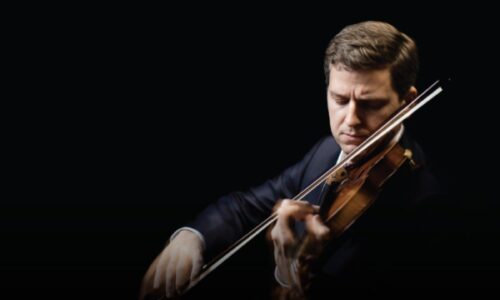 Canada Various: James Ehnes (violin and viola), Vancouver Symphony Orchestra / Katharina Wincor (conductor). Orpheum Theatre, Vancouver, 12.5.2023. (GN)
Canada Various: James Ehnes (violin and viola), Vancouver Symphony Orchestra / Katharina Wincor (conductor). Orpheum Theatre, Vancouver, 12.5.2023. (GN)

Johann Strauss II – ‘The Blue Danube’ Waltz, Op.314
Korngold – Violin Concerto, Op.35
Bartók – Viola Concerto, Sz.120 BB128
Liszt – Hungarian Rhapsody No.2 in C-sharp minor, S.244/2
Despite his international commitments, James Ehnes has always been good about returning to Canada to display his many talents. He showed Vancouver his conducting and play/direct skills in a 2017 Vancouver Symphony Orchestra festival that included an excellent rendering of Walton’s Viola Concerto. Inspired Tchaikovsky, Bach and Beethoven violin concertos have followed in more recent years.
Ehnes perhaps outdid himself here, playing both Korngold’s Violin Concerto and Bartók’s Viola Concerto. The performances were fully commanding, two of the best I have heard from him, and they highlighted the strength of his collaboration with young Austrian conductor Katharina Wincor.
James Ehnes’s 2006 recording of the Korngold concerto with the VSO under the late, beloved Bramwell Tovey remains one of the launch-pads of his international career. Originally recorded by the CBC and later published by Onyx, it is a wonderful performance, illustrating a keen identification with the composer’s special form of sentimentality and energy. Nonetheless, the current concert went further.
While there was virtuosity, feeling and a beguiling innocence of expression before, the current reading seemed to find an aristocratic awareness of the range of the work and its architecture. The lyricism of the opening movement still soars, but it is confidently wedded to the rhythmically-active features of the score, making contrasts clearer and detail sharper so that the expression seems more complete. Ehnes’s lovely bursts of virtuosity remain but did not draw attention to themselves, serving only to highlight what was being said.
Lyrical phrases fell into place beautifully in the following Romance, while the rollicking finale – with its catchy little film tune and boisterous ending – did not go wrong. Ehnes varied his attack and colour so judiciously that the whole movement flowed spontaneously in joy, providing a feast of magical violin playing. Although all three movements are based on film themes, Ehnes’s approach gives the concerto greater structural integrity than it often has, finding a special sensitivity and nobility in Korngold’s themes and an architectural strength that makes the work universal in reach.
The Bartók Viola Concerto was equally commanding – one of the most cohesive interpretations I have heard. As is well known, the work was left unfinished at the composer’s death, and was orchestrated by Tibor Serly from sketches. While other editions have come forth (e.g., Peter Bartók’s), it is the original Serly we heard here. Lest a reader have doubts about Ehnes’s abilities on the viola, it is useful to remember that he has played the instrument for almost thirty years and has done recordings of key viola repertoire for Chandos, including this concerto.
The long opening Moderato received a particularly clean execution, emerging with as much integration as I have ever heard. Taking a marginally faster speed, Ehnes managed to convey Bartókian character not so much by dwelling on the movement’s restlessness or yearning, but through a keen awareness of its idiomatic folk accents and rhythms. Violists from Yehudi Menuhin to Tabea Zimmerman have focussed on the former, attempting to probe the fragile half-lights in the writing, but at the cost of making the movement seem episodic. Ehnes’s presentation was forthright and bigger-toned and offered a valuable solution, though some may still prefer a more personal approach.
For many, the heart of the work is the Adagio religioso, and here Ehnes did seek an intimate, soliloquy-like posture. He gave a superb account, concentrated and deeply felt, bringing out some of the rarefied feelings one finds in the slow movement of the composer’s Violin Concerto No.2. It was also beautiful tonally: the burnished resonance Ehnes achieved from the lower strings of his instrument was remarkable. Much like the Korngold, joy sprang from the Hungarian rhythms of the finale, a movement that has a lovely travelogue feel insofar as it makes passing reference to earlier works like Dance Suite. Ehnes built the movement with cunning and virtuosity, ending with strong bravura. The traversal seemed especially communicative and complete.
Of course, none of this would have been possible without the contribution of Katharina Wincor, who was conscientious in her conducting, never allowing the orchestra to overwhelm the soloist. Her orchestral control and exactness in rhythm and detail were notable assets in the closing movements of both concertos. She also contributed the ‘Blue Danube’ and Liszt’s famous Hungarian Rhapsody No.2 as popular fillers, generating considerable excitement at the end of the latter.
Geoffrey Newman
